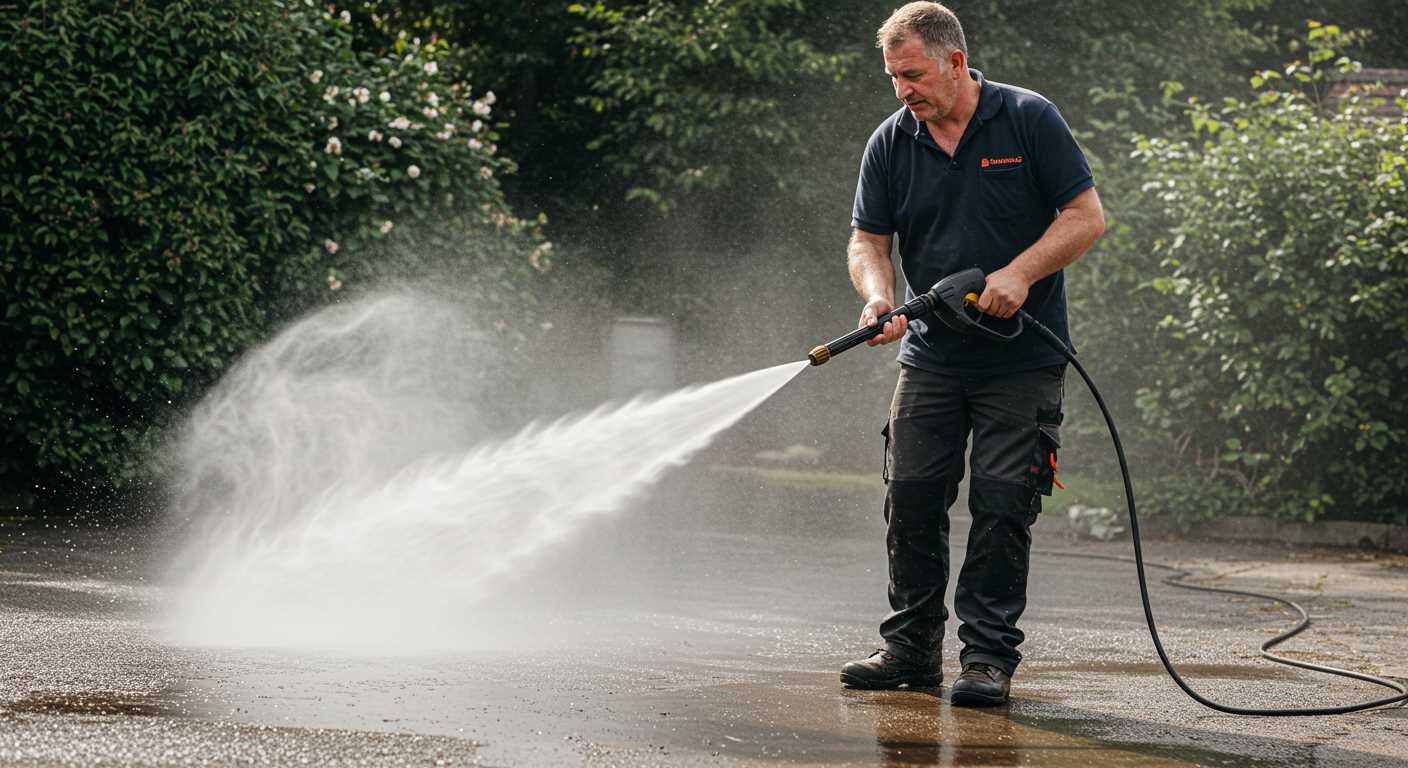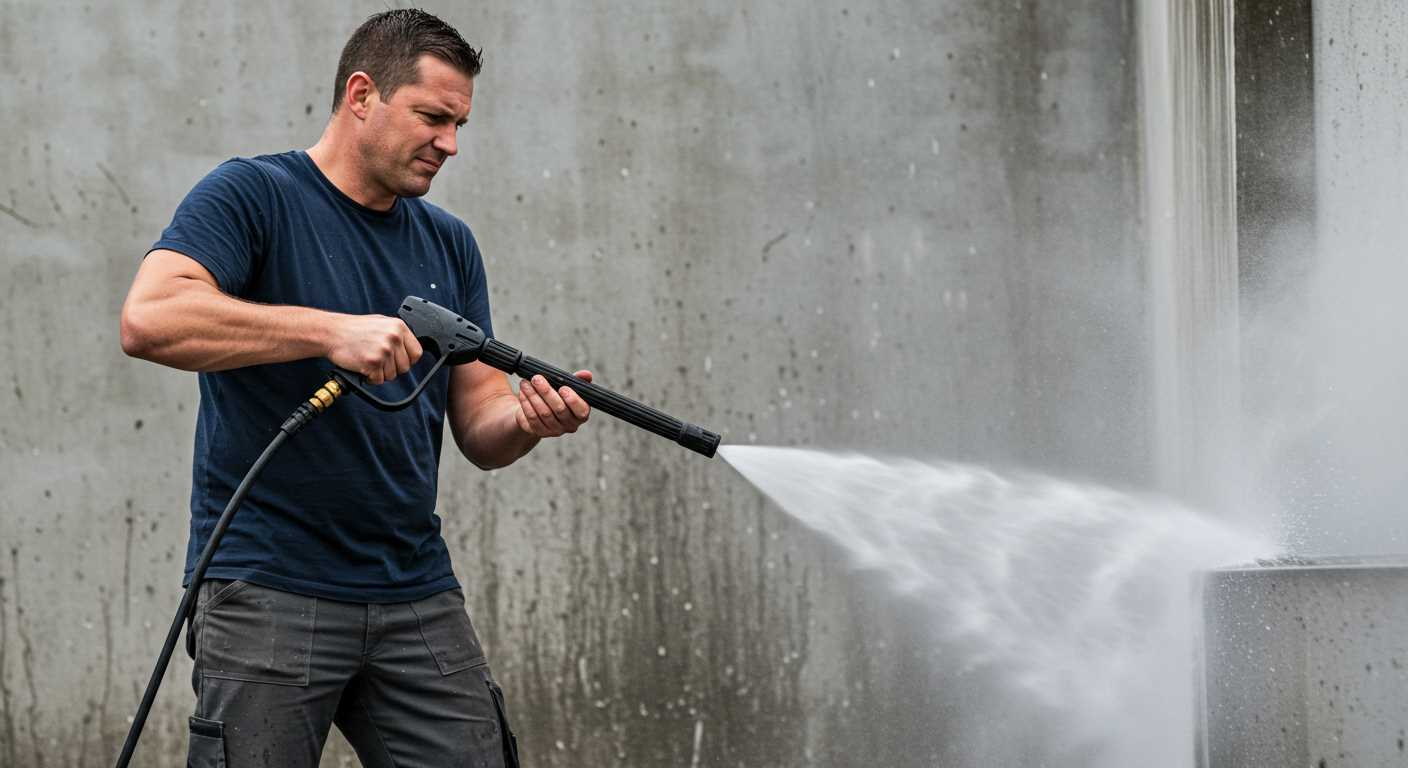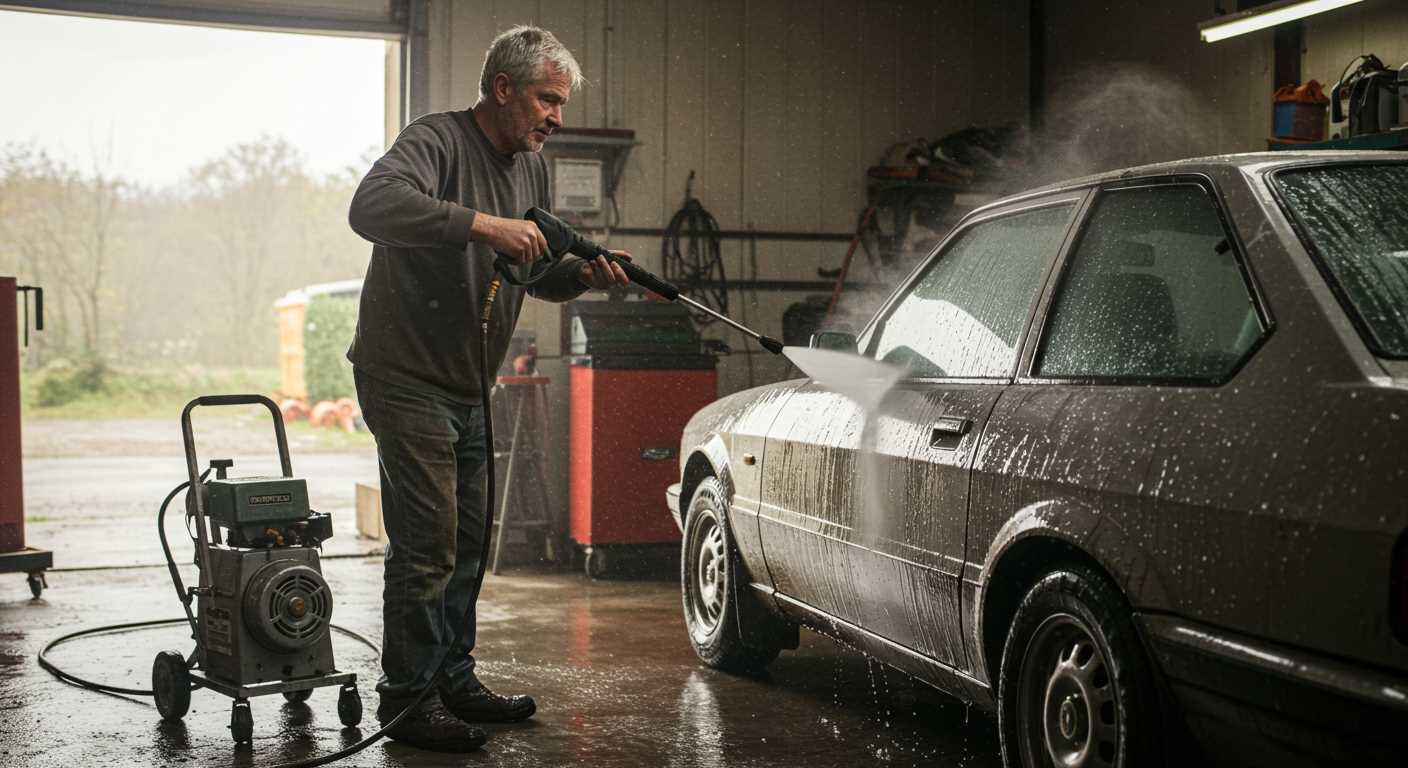



For optimal results, it’s advisable to choose a compatible detergent system specifically designed for your equipment. Ensure that the detergent tank or injection system is properly aligned with the cleaning unit’s specifications. This guarantees consistent and effective usage of cleaning solutions during operations.
Verify the compatibility of the chosen solution with the surface types you intend to clean. Some formulas are tailored for certain surfaces, so testing a small area beforehand can prevent any potential damage. A gentle cleaning solution often works best for delicate materials.
Once you’ve selected an appropriate detergent, it’s important to follow the manufacturer’s instructions regarding mixing and application ratios. A concentrated solution may require dilution, whereas pre-mixed options can be ready for immediate use. Always measure carefully to avoid any grief while working.
After filling the designated tank, maintain a steady flow when triggering the release mechanism. Adjust the nozzle for optimal dispersion of the cleaning fluid, ensuring it reaches the intended surface effectively. Take caution not to oversaturate the area, as this can lead to residue buildup.
Honestly, having the right detergent and using it correctly can make a significant impact on your cleaning efficiency and final results. With a few adjustments, you’ll notice a remarkable difference in your cleaning tasks.
Using Detergent with Your Cleaning Equipment

Fill the detergent reservoir as needed, ensuring it is compatible with your unit. Many machines come equipped with built-in tanks specifically for this purpose; simply pour the cleaner in and secure the lid. For models without a reservoir, attach a siphon hose to the detergent bottle; position the other end into the unit. Check that connections are snug to prevent leaks.
Adjusting the Nozzle and Settings
Switch the nozzle to the lowest pressure setting or a foaming attachment designed for cleaning solutions. This adjustment ensures an even application without compromising the integrity of surfaces. If your model has a detergent selection option, set it to draw the cleaner into the water stream. Refer to your manual for any specific settings recommended by the manufacturer.
Application Technique

Begin by applying the mixture from a distance, moving in sweeping motions to cover the surface evenly. Allow the detergent to sit for a few minutes to break down grime, but avoid letting it dry. Rinse thoroughly with clean water, starting from the top and working your way down to prevent streaks.
Always follow the manufacturer’s instructions regarding cleaning agents; not all formulations are suitable for every piece of equipment.
Choosing the Right Solution for Your High-Pressure Device

Select a cleaner tailored to your task. For example, if cleaning cars, opt for a pH-neutral formula to protect the finish. For tougher jobs like removing grease or oil, a heavy-duty solution is more effective. Check compatibility with your equipment manufacturer’s recommendations before purchasing.
Types of Formulations
Look for biodegradable options that are both safe for the environment and effective. The choice between liquid or foam depends on your preference and the design of your sprayer. Foam solutions cling to vertical surfaces better, allowing for longer dwell time, while liquids may spread and saturate more effectively on horizontal surfaces.
Fragrance and Allergens
Consider scents and potential allergens since some formulations can have strong fragrances or irritate sensitive skin. Testing on a small area before widespread use helps prevent adverse reactions and ensures satisfactory results.
Always follow the manufacturer’s instructions for dilution ratios and application methods to optimise cleaning power. This can significantly affect performance and results. Keeping an eye on the water temperature can further enhance the effectiveness of the chosen cleaner.
Understanding the Soap Mixing Ratio
Always follow the manufacturer’s instructions for the right dilution ratio. Most cleaners specify a mixing ratio, typically ranging from 1:4 to 1:10, depending on the product’s strength and the cleaning task. A lower ratio, like 1:4, indicates a stronger solution for heavy grime, while a ratio of 1:10 works well for routine maintenance or lighter dirt.
Steps for Accurate Mixing
- Start with water in the mixing container. Use a clean container to ensure no contamination affects the ratio.
- Add the recommended amount of concentrate. For instance, for a 1:5 ratio, if using 500 ml of water, then add 100 ml of cleaner.
- Mix thoroughly to ensure uniform consistency. Stir or shake the mixture to activate the cleaning agents.
Adjustments Based on Conditions
Environmental factors, such as temperature and humidity, can affect cleaning performance. In colder conditions, consider a slightly stronger solution to counteract the climate’s impact on cleaning efficiency. Conversely, in warmer weather, a more diluted blend may suffice to achieve optimal results without wasting product.
Test the mixture on a small, inconspicuous area before proceeding with the main cleaning task to ensure it meets your expectations. This precaution helps prevent any unintended damage to the surface being cleaned.
Accessing the Soap Injection System
Begin by locating the soap injection system on the unit, usually found near the nozzle or at the base of the lance. This part is typically a fitting designed for attaching detergent containers. Ensure the machine is powered down and disconnected from the electrical source for safety.
Next, if your model has a dedicated tank, remove the lid to expose the reservoir. This space is where concentrated cleanser is poured. If your equipment utilises an external injection system, locate the hose that connects to the injection point; it’s often clear and easily accessible. Confirm there are no blockages before proceeding.
If your setup requires dilution, verify the mixing mechanism on the machine. Some devices feature an adjustable dial that allows you to control the amount of solution introduced into the water stream. Familiarise yourself with its operation to obtain the desired ratio without waste.
After ensuring everything is clean and functional, reattach any parts securely. Double-check connections to guarantee a leak-free experience. With the system ready, proceed to fill the tank or attach the injection hose, and you are set for effective cleaning with the right mix of detergent and water.
Connecting the Soap Hose Properly
Ensuring that the cleaning fluid delivery line is sufficiently attached requires careful attention. Begin by identifying the inlet port on your cleaning machine designed for this purpose–typically marked explicitly for fluid infusion. Ensure the hose is clean and free of obstructions before proceeding.
Utilise a high-quality connector that fits snugly. A loose fit can lead to fluid leaks and inefficient operation. If you encounter resistance while attaching the line, double-check for misalignment rather than forcing it in place.
After securing the connection, inspect it for any potential leaks. This can be done by gently turning on the system at a low pressure to observe any escaping liquid. If a leak is detected, recheck your fittings and consider using plumber’s tape to achieve a tighter seal.
Once confident in the integrity of your hose connection, proceed by selecting the appropriate dilution level of your chosen cleaner. It’s good practice to consult the manufacturer’s specifications to ensure compatibility with the delivery system.
| Step | Action |
|---|---|
| 1 | Identify cleaning fluid inlet port. |
| 2 | Clean hose and check for blockages. |
| 3 | Attach the hose using a proper connector. |
| 4 | Inspect for leaks under low pressure. |
| 5 | Select proper dilution of cleaning fluid. |
After confirming all connections are secure, you can increase the pressure and commence the cleaning operation. Maintaining vigilance during this setup phase will ensure optimal performance of your equipment.
Adjusting the Pressure Washer Settings for Soap Application
Set the machine to low-pressure mode prior to applying detergent. This reduces the risk of creating excessive foam and ensures even coverage on surfaces. Adjust the nozzle to a wider spray pattern when using a low-pressure setting; a fan spray helps distribute the cleaning solution uniformly across larger areas.
For effective mixing, always follow the manufacturer’s guidelines for dilution ratios. If your unit offers adjustable flow rates, select a middle setting to find a balance that works well with the detergent you’re using.
After application, transition back to high-pressure mode for rinsing the surface thoroughly. This helps remove any residual cleaning agent effectively. Always check the user manual to verify any specific recommendations for your model to optimise performance during this phase.
Lastly, monitor the overall output to ensure that the mixture is reaching the intended surfaces; adjusting the application distance can help achieve better results when necessary. Regularly inspect the nozzle to prevent clogging, as a blocked spray can impact both efficiency and coverage.
Testing the Soap Dispensing Functionality
Begin by filling the appropriate compartment with your chosen cleaning solution. Ensure the system is fully primed and free from air bubbles. Activate the machine at a low setting and observe the flow. If the liquid fails to emerge, check the hose and any inline filters for blockages.
The nozzle’s configuration should match the solution type. Adjust it to a wider fan pattern to assist in dispersing the fluid evenly. This aids in visual confirmation of the mixture’s dispersion.
Once the settings are correct, gradually increase the pressure. A consistent stream indicates the injector is functioning well. If the mixture becomes foamy or inconsistent, it may suggest an improper dilution or blockage within the injector system.
Key measures to test:
- Inspect the injector for clogs.
- Test with different dilution ratios to find the optimal flow.
- Observe the dispersion range of the cleaning solution across various surfaces.
- Adjust the flow rate based on the level of grime on the surface.
After conducting these tests, ensure to document the observations. If unfamiliar with varying types, experiment with a few options to identify the most effective for your requirements.
Lastly, consider running a quick clean-up cycle with just water to clear any residual mixture from the system. This helps maintain the longevity and efficiency of the equipment.
FAQ:
What type of soap should I use with my pressure washer?
It is advisable to use soap specifically formulated for pressure washers, often referred to as pressure washer detergent. These detergents are designed to create a foam that can lift dirt and grime without damaging the surfaces you are cleaning. Avoid using household soaps, as they may not be suitable for high-pressure applications and could potentially harm your pressure washer.
How do I connect soap to my pressure washer?
To connect soap to your pressure washer, locate the detergent tank on your machine, which may be a built-in tank or an external container. If your model has a built-in tank, simply pour the soap into it, ensuring you do not exceed the maximum fill line. If you’re using an external container, attach the soap injector tube to the pressure washer’s wand or nozzle, then place the other end into the soap container. Always consult the owner’s manual for specific instructions, as the setup can vary by model.
Can I use a normal garden hose with my pressure washer for soap application?
Using a standard garden hose to apply soap with your pressure washer is generally not recommended. Pressure washers are specifically designed to use high-pressure water and the correct kind of detergent through their dedicated systems. If you connect a garden hose to introduce soap, it may not create the desired foaming action and could even lead to improper functioning of the machine. Instead, always follow the guidelines for soap usage as outlined by the manufacturer.
Are there any safety precautions I should take while using soap with my pressure washer?
Yes, there are several safety measures to consider. First, wear protective gear, including goggles and gloves, to shield yourself from the spray and any chemicals. Ensure that you are working in a well-ventilated area, especially if the soap contains any harsh chemicals. Always follow the manufacturer’s guidelines regarding the soap’s usage, and avoid directing the spray at people, pets, or plants. Lastly, rinse any surfaces responsibly to prevent residue build-up.









